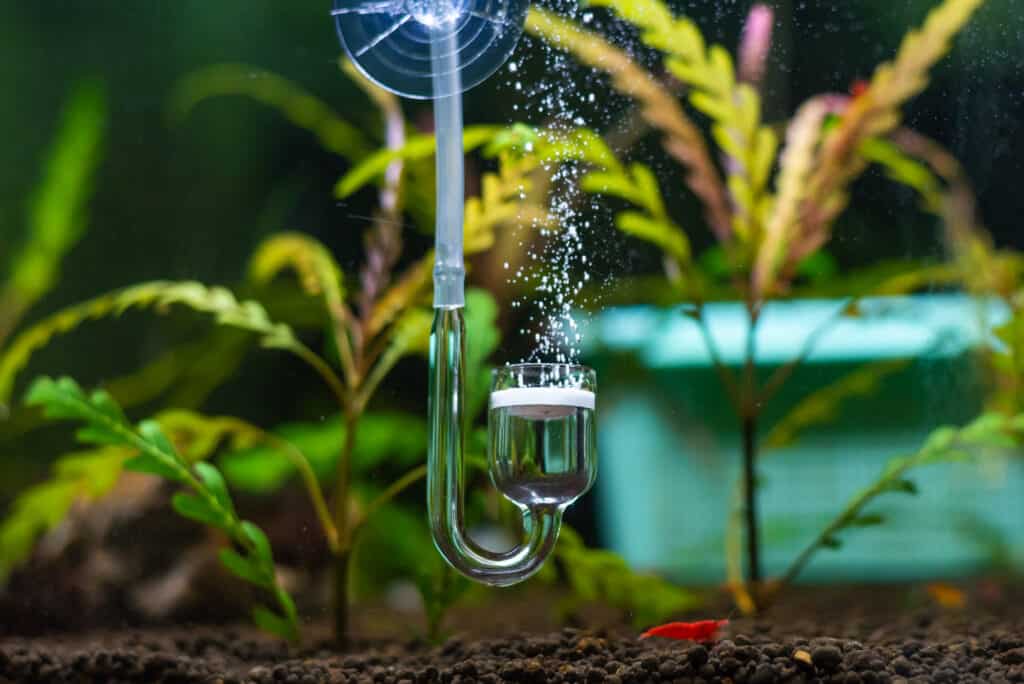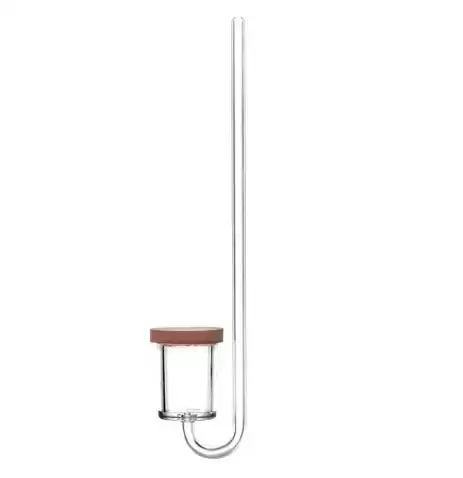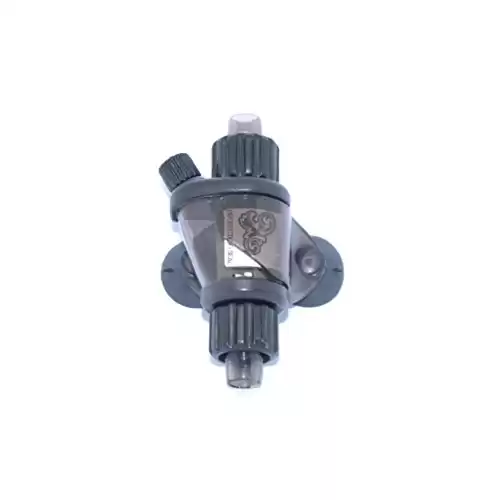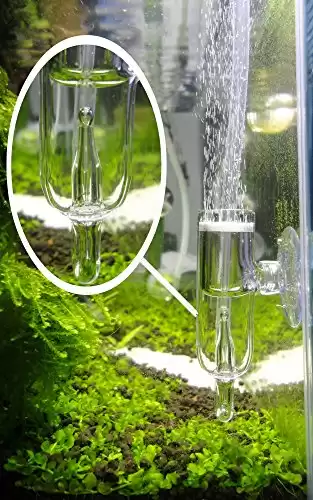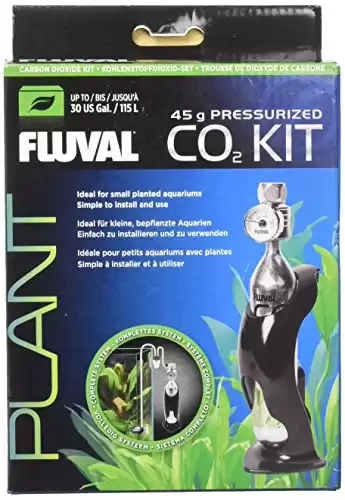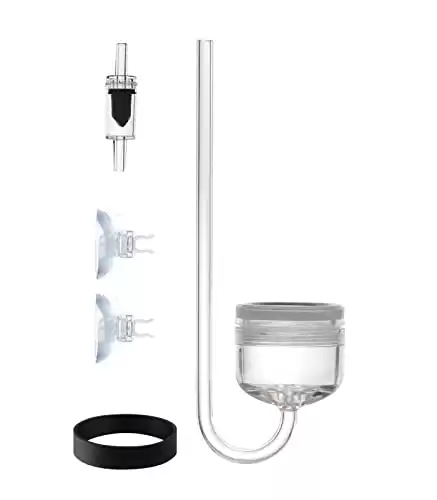Any aquarium benefits from the addition of living plants. Live plants are beautiful to look at; they help keep the water healthy and clean for your fish by taking nitrates from the water to use as fertilizer.
|
Primary Rating:
4.4
|
Primary Rating:
4.4
|
Primary Rating:
4.2
|
Living plants also help to oxygenate the water by absorbing carbon dioxide and respiring oxygen during photosynthesis.
Depending on the species of aquatic plants you want to keep and the amount of light they receive, you might need to supplement CO2 via a CO2 diffuser.
Read this guide to discover reviews of five of the best CO2 diffusers on the market.
Jardli Pollen Glass CO2 Diffuser with Bubble Counter
- Built in bubble counter
- Visually very appealing
- Efficient CO2 atomisation through ceramic membrane
- Improve the growth and health of your plants with sufficient CO2 supply
- Integrated bubble counter, so you don’t need a separate piece
- Ceramic disk attaches permanently to the aquarium glass
- No attached U-bend, so height is adjustable
This CO2 diffuser has a longer, thinner bell shape than most, and the tube that feeds the CO2 into the bell ends with a fine point.
Aquarium water flows into the bell between the tube and the ceramic disk. As the CO2 passes through the tubing, it is forced through the fine point, forming a bubble. That feature means you don’t need a separate bubble counter. Since there’s no fixed U-bend, the unit’s height is fully adjustable.
On the downside, the ceramic disk is fixed to the aquarium glass, meaning you can’t remove it for replacement or cleaning. So, you’ll need to buy a whole new unit when the disk eventually gets clogged. Also, there’s no U-bend or check valve, so you must purchase those items separately.
Finally, this glass diffuser is somewhat fragile.
What we like
- Built-in bubble counter
Room for improvement
- U-bend or check valve not included
- Fragile
- Ceramic disk can’t be removed for cleaning or replaced
Fluval Pressurized CO2 Kit
- Helpful tool to grow lush and vibrant aquarium plants
- Simple and easy to install
- Suitable for aquariums up to 30 gallons
- Country Of Origin: Taiwan
- Sturdy plastic construction
- Round plastic unit with central ceramic disk
- Perfect for small planted aquariums, 20 gallons and under
This CO2 diffuser has a round plastic body with a ceramic disk at its center, looking somewhat like a donut. Sticking up from the top of the unit is a small nipple where the CO2 line is attached. The unit attaches to the side of your aquarium via a suction cup.
Although this isn’t a professional quality diffuser, it’s tough, simple, and does the job.
The main downside of this CO2 diffuser is that it’s not aesthetically pleasing. However, you can hide the unit with your plants, and it works pretty well.
What we like
- Simple installation
- Tough plastic body
Room for improvement
- Only suitable for smaller tanks
- Ceramic disk not replaceable
- Kit doesn’t include a bubble counter, U-bend, or check valve
Clscea PMMA CO2 Diffuser
- Made of PMMA+PS, transparent like glass, not fragile, more durable than glass material.
- Suitable for pressurized CO2 supplying system. This diffuser requires at least 1kg/cm² (14PSI) working pressure for optimal operation.
- Built-in bubble counter.
- Sturdy construction
- Replaceable ceramic disk
- Integrated bubble counter
This CO2 system is an excellent diffuser that provides a high dissolution rate.
The unit has an injection-molded ceramic plate, providing an excellent seal. Consequently, the bubbles produced by the diffuser are tiny, creating an excellent dissolution rate in your aquarium water.
Unlike many other units, the ceramic disk can be replaced. Simply unscrew the plate for cleaning or replacement. The diffuser is made from PMMA+PS material that’s less fragile and more durable than glass. In addition, there’s an integrated bubble counter.
What we like
- Simple installation
- Replaceable ceramic disk
- Built-in bubble counter
Room for improvement
- Not powerful enough for large tanks
Aquario Neo Co2 Diffuser
- Aquarium Neo Diffuser - Large - 23mm
- Neo diffuser for co2 generates smaller bubbles than them from other glass diffusers
- Micro holes make it produce smaller bubbles compare to them of glass diffusers and not easily polluted for this reason
- Affordable CO2 diffuser
- Two sizes available
- Built-in bubble counter
This is an excellent CO2 diffuser for the price. The unit comes in two sizes, including a smaller one perfect for planted nano tanks. Whatever size diffuser you choose, the diffuser won’t take up too much space in your tank.
The diffuser has a U-bend that connects directly to the CO2 tubing for optimal flow. The unit is acrylic rather than glass, so it’s more resilient and less likely to break. The system can be used with a canister filter and has a check valve to prevent accidental pollution of the tank.
The system includes a built-in bubble counter.
What we like
- Budget-friendly
- Made from sturdy acrylic rather than glass
- Built-in bubble counter
Room for improvement
- Some buyers received an older, less efficient version of the model pictured
NilocG Aquatics Intense Atomic In-line Co2 Atomizer Diffuser
- Fits 1/2" inside diameter tubing - If you have questions regarding fitment please contact me prior to purchasing
- Inline design for use with canister filters, Super fine and high rate of CO2 diffusion | Total 100% dissolution in water
- Premium quality inline diffuser
- Two sizes available
- Highly effective with a 100% CO2 dissolution rate
The NilocG Aquatics Intense Atomic In-line CO2 diffuser is a premium model and an excellent choice if you don’t want the hassle of fiddling with suction cups and changing ceramic disks.
The unit comes in two different size options, and the manufacturer encourages buyers to double-check that they’ve selected the correct size for their setup. If you have any questions, please contact the supplier, who will be pleased to help you.
This inline CO2 diffuser is designed for use with canister filters and requires a pretty reasonable PSI rate to operate efficiently. However, this tank diffuser will give you a tiny bubble size and 100% dissolution in your water column if you have the proper setup.
The system is easy to install and operate. Although slightly more expensive than more traditional ceramic disk options, this CO2 diffuser is excellent value for the money. The unit produces an excellent CO2 diffusion rate and an ultra-fine mist of bubbles throughout the water column, which is great news for your plants.
What we like
- Professional quality, inline diffuser
- Suitable for use with canister filters
- Excellent CO2 diffusion rate and tiny bubble size
Room for improvement
- Some buyers reported missing diffuser equipment items from the kit when it arrived
What Is The Purpose Of A CO2 Diffuser In An Aquarium?
All aquatic plants need carbon dioxide (CO2) for healthy, vibrant growth.
Generally, your aquarium plants get all the carbon dioxide they need from the water. Fish respire CO2 and surface agitation also enables efficient gaseous exchange.
A diffuser or CO2 system supplies the aquarium with extra carbon dioxide. There are various types of diffusers that work slightly differently. However, the primary function of a CO2 system is to force tiny bubbles of carbon dioxide into the aquarium water, facilitating the efficient dissolution of the gas for the plants.
Do You Need a CO2 Diffuser?
If you have a planted aquarium, your plants need CO2 for respiration and growth through photosynthesis.
Your plants need a continual supply of CO2 during daylight hours. The plants combine CO2 with water and light energy to create the sugars and oxygen they need for growth.
Wild plants get all the CO2 they need from the substrate and decaying plant matter. However, in the enclosed environment of the aquarium, the supply of CO2 is somewhat limited. There’s little CO2 in tap water, and plant decay is minimal compared to the wild environment.
So, many hobbyists use supplementary CO2 to help their plants grow better and more robust, and if you want vibrant, lush plant growth, a CO2 diffuser is recommended.
Light vs. CO2 Injection
Whether or not you need to use CO2 injections in your aquarium depends largely on the amount of light your plants receive and the species of plants you want to grow.
In a low-light tank, you don’t generally need CO2. Plants tend to grow less under low light, so you don’t need to provide additional CO2 since there’s usually enough coming from surface agitation, decaying plant matter, and fish respiration.
However, adding CO2 to your aquarium can boost your plants’ growth quality and overall health.
In a medium to high-light planted tank, CO2 injections are essential. The more light available to the plants, the quicker they will grow, so the more CO2 the plants will demand.
Under those circumstances, you’ll need to add CO2 to cope with the plants’ needs. If your fish tank remains CO2-limited, your planting will suffer from growth issues, which can lead to algae growth.
How to Choose Your CO2 Diffuser
There are several factors to take into account when choosing a CO2 diffuser.
You can choose CO2 systems that use compressed gas, powered by disposable or reusable bottles, or bio CO2. Bio CO2 systems tend to be too underpowered to be effective in most larger aquariums and need higher, constant CO2 pressure to function properly.
Pressurized gas systems provide more consistent performance and much higher pressure. That gives you many more options when choosing the best CO2 diffuser for your needs.
Invisible CO2 Technology
Inline diffusers are a good choice for large fish tanks and more puristic aquascapes where you want as little of your aquarium tech to be visible.
Inline atomizers can be installed between the outlet and external filter in the hose section of an external filter, remaining out of sight in your cabinet. An inline diffuser fits most standard hose diameters and doesn’t influence the filter flow rate.
These inline devices produce extremely fine atomization, and they are totally silent. However, an inline atomizer needs relatively high pressure to operate correctly, ideally 1.8 or greater.
When running an inline CO2 diffuser, the microfine bubbles flushed into the aquarium via the filter outlet are barely visible.
Ceramic Membrane Quality
The quality of the membrane in your diffuser massively influences the solubility of CO2 in your fish tank water.
Typically, the finer the membrane’s pores, the finer the bubbles it produces. Smaller CO2 bubbles have a bigger surface-to-volume ratio than larger ones. That means the carbon dioxide gas dissolves faster in the water.
However, finer atomization needs a higher working pressure in your CO2 diffuser, typically 2 bars. Generally, plastic, acrylic, stainless steel, glass diffusers, and inline atomizers are fitted with extremely fine-pored ceramic diffuser membranes.
How Big Of A CO2 Diffuser Do I Need
Size is important when choosing a CO2 diffuser; a unit designed for a 10-gallon aquarium simply won’t cut it in a 55-gallon tank!
How so?
Well, the surface area of the ceramic diffuser disc won’t be big enough to push out the volume of gas that’s required for that much water. In addition, a smaller diffuser isn’t designed to cope with the high pressure required for a large aquarium.
On the other hand, using a diffuser intended for use with a larger tank in a small setup means that the lower CO2 pressures probably won’t be able to push the gas through the ceramic disk.
Bottom line: always buy the correct size of CO2 for your tank size.
Very Large Tanks
So, the larger the aquarium, the larger the CO2 diffuser you’ll need, and the greater the diameter of the unit’s ceramic membrane should be.
For a very large tank with a volume of over 140 gallons or for long tanks, it’s best to use two CO2 diffusers. Install one unit on the left and one on the right side of the tank to provide a more consistent and constant CO2 distribution.
Materials
As mentioned earlier, CO2 diffusers come in several different materials, typically acrylic, steel, plastic, or glass.
If you have a glass or stainless steel inlet and outlet pipes in your aquarium, it looks better aesthetically to use the same materials for CO2 tech. Many hose connectors and diffusers come in a stainless steel or glass variant.
Those units are usually fitted with extremely fine-pored ceramic membranes, some of which are replaceable, depending on the model. That’s worth bearing in mind when it comes to replacement or repair.
Overall Quality
When considering which CO2 diffuser to buy, don’t be tempted to choose the cheapest model. Unfortunately, cheaper units rarely work as well as more expensive ones, and if your diffuser doesn’t distribute CO2 efficiently through your tank, you might as well throw your money away!
We recommend buying the best quality CO2 diffuser you can afford. Not only will the unit function much more efficiently, but it will most likely last much longer than a cheap one.
What’s In The Kit?
Many diffusers include additional equipment in the kit, such as bubble counters, U-bends, and/or check valves.
That’s well worth considering when making your choice, as you can end up spending a lot on extras that aren’t included.
Where Should You Place Your CO2 Diffuser?
Where you place the CO2 diffuser in your tank is crucial if the unit is going to work properly.
Ideally, you want the unit in the downwash current from the filter outlet. The current in the aquarium water should carry the carbon dioxide bubbles from the diffuser from one end of the tank to the other.
If the CO2 bubbles rise vertically instead of being carried along in the down current, the diffuser is too small for the tank, or the flow rate is not powerful enough for the chosen unit.
How To Install Your CO2 Diffuser
Assembling your new CO2 diffuser unit is actually pretty straightforward once you know what you’re doing!
The following graphic shows you how your CO2 diffuser system should be set up:
CO2 Diffuser System Set Up
 Graphic courtesy of Aquarium Gardens
Graphic courtesy of Aquarium Gardens
How To Set Up Your CO2 Diffuser System
Here’s an overview of how to set everything up:
- Use a wrench to tighten the regulator to the CO2 bottle.
- Fit all the other system components together, as shown in the diagram above.
- Once you’ve connected everything, open the needle valve on the regulator slightly before you release the gas from the bottle. That avoids damaging the solenoid when the main valve on the bottle is first opened.
- Next, turn on the main valve on the bottle and release the CO2. The lefthand gauge on the regulator will move to roughly 800-1000 psi to indicate that the bottle is full.
- To release CO2 from the regulator, gently turn the needle valve about half a turn, and watch for the CO2 bubbles to become visible through your bubble counter.
- Adjust the needle valve once more to produce one to two bubbles per second through the bubble counter. Note that you might need a higher rate in larger tanks.
- When adjusting the CO2 rate, remember that the needle valve is pretty sensitive. So, use minimal movements to alter the rate.
- Monitor the CO2 levels closely over the next couple of hours using a drop checker. Make any necessary adjustments until the drop checker fluid turns green. Allow an hour or so for the drop checker to react to the levels of CO2. Your drop checker will show the previous hour’s carbon dioxide levels.
- You can set the solenoid using a simple electric plug timer to turn off the CO2 at night.
CO2 Diffuser Top Tips
Here are some handy tips for using your CO2 diffuser.
- Remember to turn off your CO2 diffuser about an hour before your aquarium lights go out. The CO2 levels in your fish tank will be enough for your plants for the last hour of their photosynthesis period, saving your CO2 consumption.
- Set the solenoid to switch on the CO2 one to three hours before the aquarium lights come on. The most critical time for plant photosynthesis is at the start of the photoperiod. You achieve the optimum concentration for the plants by increasing CO2 levels in the water in advance. Your drop checker should show a good green color at the start of the photoperiod.
- Be prepared to experiment a little with the bubble count and your CO2 on/off times. Every aquarium is different and needs differing CO2 rates to hit that green sweet spot on the drop checker.
- Don’t go mad with CO2 levels, as that could be harmful to your fish. Begin with low levels and gradually increase them.
- We recommend you experiment with CO2 levels before introducing fish to your setup. That prevents putting your fish at risk while you find the optimum CO2 level for your plants.
Contact the manufacturer or your local fish shop experts for advice if you have any questions about setting up and operating your new CO2 diffuser.
Final Thoughts
I hope you enjoyed our guide to CO2 diffusers and found our product reviews helpful. If you did, please share the article.
If you have a densely planted tank with low light levels, a CO2 diffuser can help to provide supplementary carbon dioxide to encourage better plant growth. However, if you have an efficient filtration system that provides plenty of surface agitation to promote good gaseous exchange and a well-stocked tank, a CO2 diffuser might not be necessary.
Do you have a CO2 diffuser in your setup? Tell us which one you chose and why in the comments box below.

